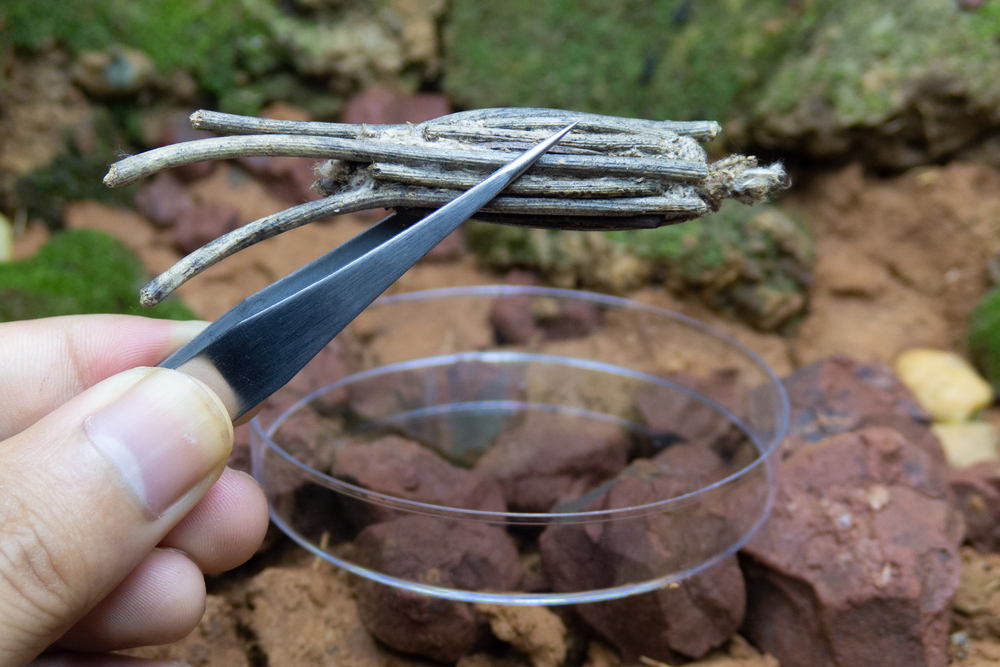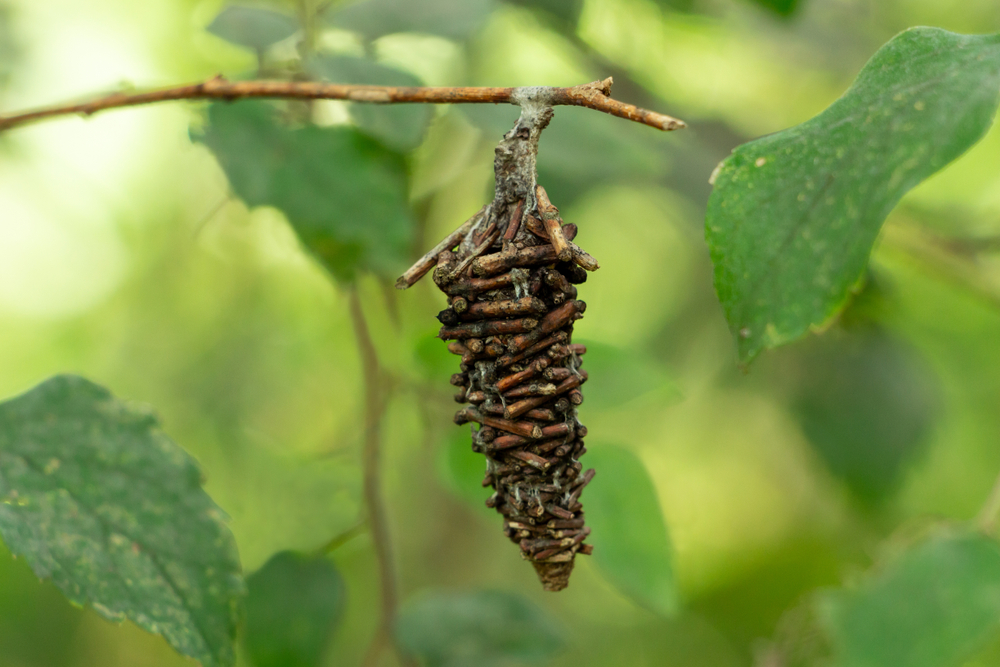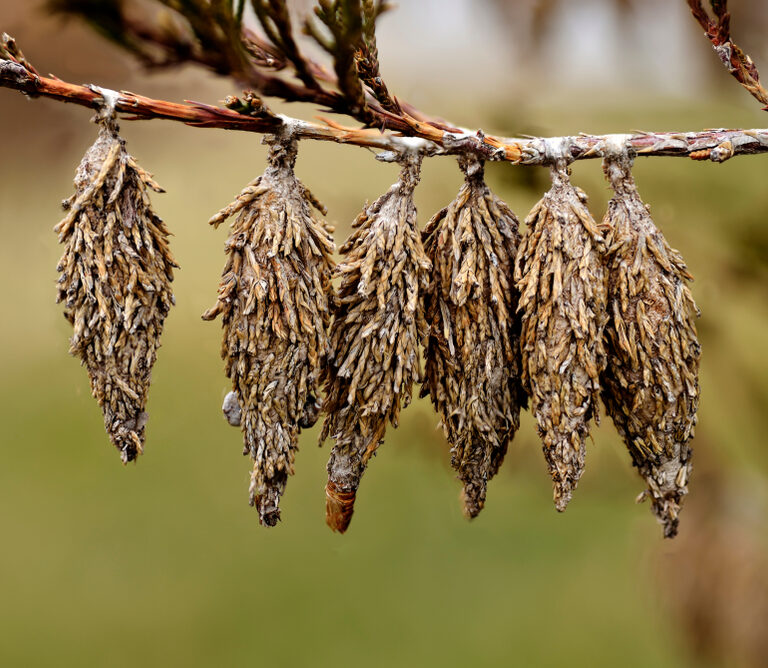While it may not look like it at first, bagworms are some of the most common urban tree-damaging pests in the US: a single female bagworm can lay up to 1,000 eggs in her lifetime. They cause severe defoliation because their diet consists of tree leaves and branches. It only takes four bagworms to overtake and damage a four-foot tree.
Their name comes from the small little sacks where they spend most of their lives. These brown bags are made out of tree branches, leaves, and silk. They offer bagworms protection from predators and the elements. Once their mating cycle comes to an end, the eggs remain inside the bags, where no insecticide can kill them, until a new cycle begins.
To get rid of them, you will need a lot of planning, timing, and the right information. Here’s how to get rid of bagworms.
The Best Ways to Get Rid of Bagworms
1. Attract Predators
Getting nature on your side is one of the most effective ways to get rid of bagworms, but don’t worry, you won’t have to sing like Snow White or tame any animals. These pests are susceptible to a wide range of predators, diseases, and parasites. Out of everything on the horrific list of things that eat bagworms, birds are the tamest solution.
You want to attract swallows and finches because they look at bagworms as if they were Beluga caviar. The first step to attracting these animals is to make your backyard bird friendly.
If you commit to this method, avoid the use of insecticides. Without plenty of bagworms to eat, animals will skip your backyard even if it looks like The Ritz-Carlton for birds. Here are the best ways to attract these kinds of birds:
Food
As mentioned before, finches and swallows love to eat insects, but they won’t just show up in your yard. You can help them by encouraging insects to gather around the bagworm-infested tree. To do this in a controlled way, let the grass around the tree grow slightly more than the rest of your property. Insects will flock there for shelter, with birds following soon after.
Swallows have no interest in seeds, but finches do. They have a preference for dark types like sunflowers. You can set up a feeder in the infested tree with a few sunflower seeds to attract them, but enough for them to rely solely on it. Once they have eaten the food, they’ll turn their attention towards the bagworms. If you’re lucky, birds may even nest in the tree.
Water
Swallows and finches have a preference for moving bodies of water rather than static. You can imitate this by setting up a bird fountain for them to rest and bathe in. Keep the water clean and put some stones at the bottom to reduce the risk of birds drowning. You don’t want to get rid of the wrong animal.
Perching
These types of birds prefer to perch in open areas. You can simulate this by placing a long clothing line between different trees or poles. If you have pets, try to keep them inside, so the birds can comfortably sit around and identify the bagworms.
Color
Birds are curious about the type of colors they don’t usually see in nature. You can get their attention by using some bright-colored ribbons, like red or yellow. Place the ribbons high in the trees, making them easy to spot from above.
2. Use Nematodes
Insecticides are only effective during certain months of the year. Bagworms are actually not worms but caterpillars that turn into moths. Their eggs hatch around mid-May, and they feed until late August or September. Using an insecticide outside of that range is very ineffective because the moths are already gone. Once they turn into moths only their eggs are left, which are protected by their bags. The most effective time to eradicate them is when they’re out of their bags, either feeding or mating.
They mate once a year, meaning that if you missed your chance to spray them, you need to wait for the next year. The good news is that damage to the tree won’t continue until the next generation of bagworms comes around.
To know exactly when they hatch, place a couple of their bags in a mason jar during winter and seal it. The caterpillars in the glass jar will hatch at the same time as the ones in the tree. This way, you’ll know when the perfect time is to spray them.
The most effective type of insecticide is bacillus thuringiensis. This bacteria effectively gets rid of moth and butterfly larvae. Consider applying the insecticide various times through May and June. The longer you wait to spray the insecticide, the harder it becomes to get rid of this year’s bagworms. If you need to reach high areas, consider using a backpack sprayer.
Here’s a list of other insecticides that are effective against bagworms:
- Carbaryl
- Orthene
- Permethrin
- Pyrethroids
Always read the product’s label before applying. These chemicals have different effects that could negatively impact specific plants.
3. Remove Them by Hand

If you missed your yearly chance to use insecticide, consider picking the bags one by one. This method works better during winter-time when the next generation of bagworms hasn’t hatched yet. All you need is patience and some time on your hands.
To make sure you have taken care of the eggs, you have to either crush the bags or drop them in a bucket with soapy water. The second option is less messy and more practical and you could use any type of soap. Picking up the bags works better when the trees are not too close together, as these infestations tend to be localized.
FAQs
Do Bagworms Affect All Types of Trees?
No. Bagworms have a preference for evergreen trees, including pine, spruce, and junipers. While you can find them in other types, their damage is not as severe as on very leafy and branchy trees.
Can Trees Recover From Bagworm Damage?
There’s no chance of coming back for a tree that has completely turned brown because of bagworms. You can save the tree as long as there are remaining green parts. However, because of the extensive damage, the areas where the tree has withered may never grow again.
Do Bagworms Spread to Nearby Trees?
They do if the trees are close enough to each other, which tends to be a common problem in urban areas. When larvae hatch from their eggs, they start to release a lot of silk. Aided by the strong wind currents, their silk build-ups propel them into the air. These air currents help them populate nearby trees, thus, starting new infestations.
What Do Bagworms Turn Into?
After their feeding cycle ends, males transform into moths. They leave their bags on the lookout for mating partners. Females, on the other hand, do not develop wings. They stay inside their bags where they lay their eggs.
Final Thoughts

Bagworms are not an easy pest to get rid of unless you know what they are. While nature does an excellent job of taking care of them, a little intervention goes a long way. Timing also plays a huge role in the eradication of this pest. Yet, being on the lookout and controlling their population by hand now and then is a great way to keep your trees green and flourishing.
